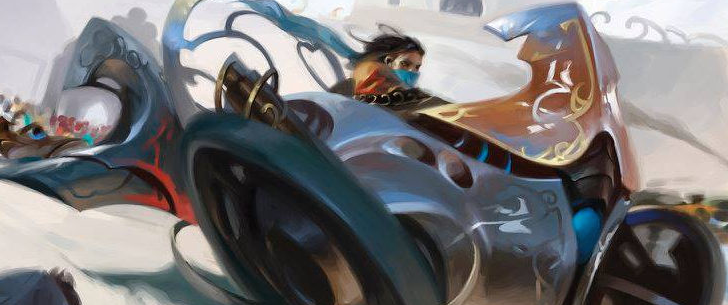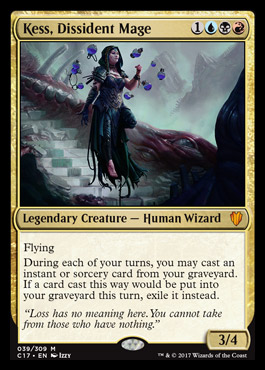Uncompetitive Spirit — Chase

Welcome to December's first installment of Uncompetitive Spirit! Here we celebrate not only the holidays, but also the quirky ways to play EDH with our friends - format variants! In this article series, I discuss the basic rules and strategies for each of these variants, and I also throw out a deck generated by this very website into the Uncompetitive Arena and see how that deck would fare in the format variant of the article! Today: a pretty standard special way to play: I'm going to call it "Chase".
1994, Richland, WA. At RadCon, Richard Garfield himself hosted a game of Magic featuring no less than 40 players! It's likely not the biggest single game of Magic ever played, but it's pretty impressive, and four times larger than the single biggest game I've ever partaken in myself. The format for this instance was Grand Melee, a multiplayer variant which allows for a very large amount of people to play in a single game. Using moving turn markers, players around the table take their turns simultaneously and compete to knock out the opposition in front of them (quite literally) and strive to be the last planeswalker standing. The variant I'm going to discuss today is similar to Grand Melee in that it allows for a larger game, played at a bit faster pace. My local group calls it "Chase", though I wouldn't be surprised if there are other names of very similar variants around.
Chase: the Basics
This variant is suitable for 4-6 players. It uses the following basic rules differences from regular EDH:
- Player's seats are randomized. This is very important.
- Turn-order follows clock-wise.
- Players attack only the opponent to their own left, and defend against only the opponent on their own right.
- When a player is eliminated, the player who was attacking him or her continues to attack the next one "in line", hence the players "Chase" each other around the table.
- Optional: Unlike Grand Melee, spells don't have any particular "reach", as in, your spells can only affect the opponents sitting close. All players can target anything on the board, and spells affect everything on the board. If you play larger games than 6 using these rules, I'd recommend at least discussing a "reach" rule.
And that's pretty much all there is to it. The question that remains is: why even bother with this variant? The reason is two-fold: first, it does help speed up the game a bit, if not by a whole lot. Second, it adds a new layer of interactions by essentially restricting other intrinsic layers of the game. By restricting the attacks available to all players - new diplomatic dynamics open up at the table. I will elaborate on this later on.

Very good, though perhaps not entirely because of vigilance only.
The reason it speeds games up is quite simple: combat math gets a lot easier when you only have to consider one opponent for attacking or blocking. In most games of EDH - if you're up against three opponents, you have to consider that all three of them could strike back at you in their following combat steps. This is why vigilance is such a useful, and in my opinion highly underrated ability, in EDH. Chase doesn't have the exact same version of this, because not only is the opponent attacking you always known (and only the opponent attacking you), the person you are attacking is unable to strike back - at least insofar as he or she can't actually attack you back.
Chase does come with the inherent frustration of the Magic version of being stuck between a rock and a hard place, something along the lines of being stuck between getting chased by Xenagos, God of Revels and chasing Grand Arbiter Augustin IV. This is somewhat alleviated by the inherent tactics of the format, however.
Chase: Tactics
Because of the rules changes in this variant, the diplomacy gets muddled right from the get-go. Because it's so clear exactly who can attack who, it works a lot more like 1 vs. 1 Magic, at least in the very beginning of the game. However, as soon as someone starts to establish a board position, this begins to change. For example: let's say that a player is off to a really fast start at the very beginning of the match, and starts hammering away at his chased opponent as soon as possible. This opponent, seeing that he is in danger, might like to try and broker deals with the player he or she is chasing, in order to get help to sort out the one chasing him or her. "I won't attack you for X turns if you help me deal with this threat", and the like. This is the reason why I don't think that "reach" rules are interesting in these games, at least not when it's at seven or fewer players.
In the same example, the player chasing the recently-realized diplomat might try to engage other players around the table to help him deal with the defense of the diplomat. Since the options for attacking is limited, so will the deal broking be as well, but the clarity helps people negotiate since the chances of backstabbing are essentially limited to using spot removal or sweepers in a way that was unintended and the like.
So, despite the fact that you, at least given a single point in time, have fewer opponents in Chase than in regular EDH, the politics doesn't get any less necessary or interesting.
Sweepers are, as in regular EDH, very valuable. In fact, they might be even more valuable in Chase since while the affect the entire board, you're most of the time only threatened by a single player, you can save them for longer usually. Use them vary sparingly, however, since they might draw out hard feeling from other players who aren't chasing you at the moment. Conversely, being the Aggro player is again very tough - you have to be progressing your board state of course, but be careful and try not to over-extend; even if you are only attacking one player, the player next to him or her might see you as a threat and take action before your current target is taken down.
Uncompetitive Arena: Kess, Dissident Mage
This week, we're going to toss Kess, Dissident Mage into the Uncompetitive Arena, and see how she would fare in a game of Chase EDH. To start us off, let's have a look at the average Kess, Dissident Mage deck from EDHREC:
Looking around at different lists for this particular commander, there seems to be quite a few different possible directions. Some like to go storm and kill the entire table with a huge Mind's Desire into Tendrils of Agony or similar. Some like to go the control route and try to take a hold of the table and win slowly. I'm in the later camp with my own Kess, Dissident Mage deck, but that's neither here nor there, because we're looking at one from this very site. My point is, I expected the deck to be less refined than it actually is, this seems more focused towards the control route, and while I have no comment on which of the two is actually better, it's likely better to focus on one plan rather than two in most cases.

Kess, Dissident Mage is one of the breakout commanders of this year's set, in my opinion, and EDHREC's statistics seems to support my view. This week, she is currently joint-third behind one other newly printed commander, Edgar Markov and she shares her spot with The Ur-Dragon. This month, she is third again behind Edgar Markov and the seemingly ever-popular Atraxa, Praetor's Voice. She is within her own colors also doing well, currently sitting at sixth place, ahead of both of her boxed Grixis companions of Inalla, Archmage Ritualist and Mairsil the Pretender.
It's easy to see why she is so popular - Snapcaster Mage is a very powerful card and has been played in all formats it's ever been legal in, and Kess, Dissident Mage does a good job emulating the power, while also bringing arguably one of the more powerful color combinations of the format to the table. I also think she would do well in a game of Chase EDH with the list above, although there are some issues and there are several small tunings we can do to enhancer her abilities in similar variants.
From the list, we can conclude that she has the ability to protect herself from a single opponent quite well. A relatively large number of spot removal helps keeping the heat off of her back, while also being suitable for diplomatic play. For those nasty board states, she comes equipped with a few of the best sweepers in the format in Blasphemous Act, Damnation, Decree of Pain and Toxic Deluge. The deck does seem to suffer a bit from the "precon disease", however, since both Pongify and Rapid Hybridization are missing, two premiere removal spells both very effective and cheap, which is important if you're looking to cast multiple spells in a turn.
The deck does come with some drawbacks, and that's board presence. It's likely Kess, Dissident Mage will fly under the radar in a game of Chase EDH for quite some time, but she has relatively few ways of actually getting combat done. If she spends too much time defending against the player chasing her and not disrupting the one she is chasing or establishing a board presence of her own, it's likely the player ahead of Kess, Dissident Mage will run away with it. That's not her problem, however, at least not until all the other players are dead. To remedy this, I personally like to both include a few top-tier finishers such as Inferno Titan or Grave Titan. Grixis also has access to some really good and effective clones in cards such as Dack's Duplicate, Phyrexian Metamorph, and Clever Impersonator which can piggy-back on other players' stuff and create threats for much cheaper than is fair. Finally, I would likely never sleeve up Dimir-colors (paired with anything really) without including Baleful Strix. It's such a powerful card, at such a low cost, and even if you have zero ability to interact with the enters the battlefield-trigger, it's still worth a slot in almost any deck that could play it.
The Paper Chase
That's it for this time, folks. Leave your comments and suggestions below! Until next time, stay awesome and keep it casual!
EDHREC Code of Conduct